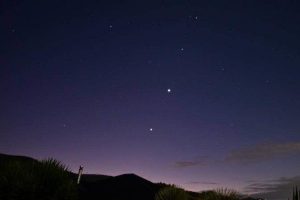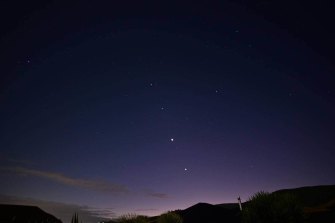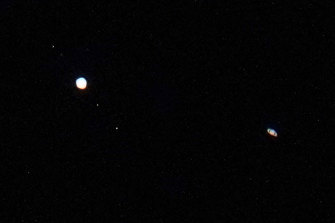‘Super bright’: Stars align as Venus and Jupiter set to light up the sky

Early risers on Sunday will be treated to a rare planetary phenomenon – if the skies are clear.
For the next month or so, four planets will be in alignment: Saturn, Mars, Venus and Jupiter. But in the predawn eastern sky on Sunday, Venus and Jupiter’s positioning means they will appear together as one bright light.
Saturn, Mars, Venus and Jupiter in a straight line, seen from Richmond, near Nelson in New Zealand this week.Credit:Greg Price
Dr Brad Tucker, an astrophysicist at the Australian National University, said the alignment was “a really cool and special thing”.
“Venus and Jupiter will appear as one object. It will look like they’ve merged into one – they’re not social distancing or anything,” he said. “It will kind of merge into this super bright thing.”
Tucker said between 5 and 5.30am AEST was “the sweet spot” for the best time to glimpse the phenomenon because Jupiter would be above the horizon by then, and it will still be dark enough before the sun begins lighting up the sky.
“Jupiter is pretty low around 5am. If you hold your fist at arm’s length, Jupiter is about two fists above the horizon, and they go up higher from there,” he said. “Neptune is there too, but it’s too faint to see with the naked eye.”
Jupiter, and three of its moons (left) and Saturn (right) are seen above Chicago on December 22, 2020. The two planets were then in their closest observable alignment since 1226.Credit:AP
The only hitch is the weather. After several cloudy days this week, the Bureau of Meteorology predicts a slight chance of a shower on Sunday morning, before fine weather continues next week.
For stargazers who miss Sunday's alignment, Venus and Jupiter will still appear close to each other on Saturday and Monday, but will gradually separate.
Dr Sara Webb, from Swinburne University's Centre for Astrophysics and Supercomputing, said the different orbiting patterns and speeds means these events are very rare.
“In reality, the planets are ridiculously far away from each other, but this chance alignment is a total treat for us here on Earth,” she said.
“I love just the wonder it brings back into people's lives. It is so easy to get caught up with 21st-century life and forget that marvel of our own existence on a little rock floating in space.”
Webb said the beauty of this celestial event was that anyone will be able to see it.
“Living in a city can almost completely remove the brilliance of the night sky, but these planets are so bright [that] anyone anywhere in Australia should be able to spot them.”
Tucker said the alignment would last for a month “until we get into June when Mercury joins the party for a short few days. Then we lose Merc, then we lose Venus, then the band is disbanded.”
The Sydney Observatory, which is closed for maintenance, suggests using binoculars to “really enhance the view”.
The observatory describes Venus as “easily recognisable as a very bright and white ‘spotlight’ above the eastern horizon before dawn”. Mars is reddish and fainter than Venus. Jupiter is bright and yellowish, while Saturn is also yellowish like Jupiter but fainter.
Our Breaking News Alert will notify you of significant breaking news when it happens. Get it here.
Most Viewed in National
From our partners
Source: Read Full Article


